Source: The Patriot (London) 12 September 1853
It is no misnomer Cordial! —no stupefactive, deadly narcotic! —but a veritable preservative of Infants!
Regular readers of The Quack Doctor might be able to hazard a guess at the active ingredients of this product. Like other infant quieteners, it did contain a narcotic, and, like them, it was a killer.
One unusual thing about Atkinson and Barker’s Royal Infants’ Preservative, however, was a particularly dubious form of promotion.
A few hours after my son was born in 2007, the only person in the post-natal ward who noticed I was there was a sales rep who came to present me with Pampers vouchers and sign me up to mailing lists for catalogues full of baby-related crapola. In hindsight I am mildly outraged at the tackiness of this marketing ploy, but at the time I was happy to see a friendly face, and handed over my details. The only harm done was a bit of junk mail that’s still turning up three years later. What I didn’t know at the time was that a similar practice was in operation in the 1870s, with far more sinister results.
In 1876, Kilburn doctor William H Platt wrote to the medical journals to highlight an issue he’d discovered quite by accident. Local parents were finding flyers for the Royal Infants’ Preservative enclosed with their children’s vaccination papers. At this period, vaccination against smallpox was compulsory, and these official documents were sent out to all who had registered a birth. Platt surmised that someone from the company had done a dodgy deal with the Board of Guardians to come up with this plan.
The result, he believed, was:
…to induce the people receiving these papers, many of them poor and ignorant, to believe that these so-called infant preservatives are recommended by the same authority which enforces vaccination.
The handbills involved would have been something like the above, and as you can see, they also purport to have the ultimate celebrity endorsement. Atkinson and Barker were ‘Chemists to Her Majesty in Manchester’, but quite how often she popped into their Bowdon warehouse I don’t know. The relationship mainly involved the company trumpeting the royal connection and boasting about the time they sent the Queen a gift of the Preservative in a classy bottle.
The mixture’s composition was listed in the Druggist’s General Receipt Book in 1878.
Carbonate of magnesia 6 drs.
White sugar 2 oz.
Oil of aniseed 20 drops
Spirit of sal volatile 2 drs.,
Laudanum 1 dr.,
Syrup of saffron 1 oz.,
Caraway water to make a pint.
(‘dr’ refers to drachms)
The amount of laudanum was pretty small, but then so were the people who received it. In 1886, an inquest on the body of a six-week-old baby decided that a mere six drops of Royal Infants’ Preservative had been enough to kill it, as it was already weakened by illness. Surgeon Mr H S Leigh told the jury that when he saw the baby the morning after the dose,
…its pupils were contracted to the size of a pin’s head; it was covered with a cold, clammy sweat; it was breathing about six in the minute, and was apparently moribund.
The child ‘lingered on till evening, when it died.’
The Preservative had been around since the 1790s. In the 1830s, artist O. Hodgson satirised parents’ reliance on such products with the following cartoon.
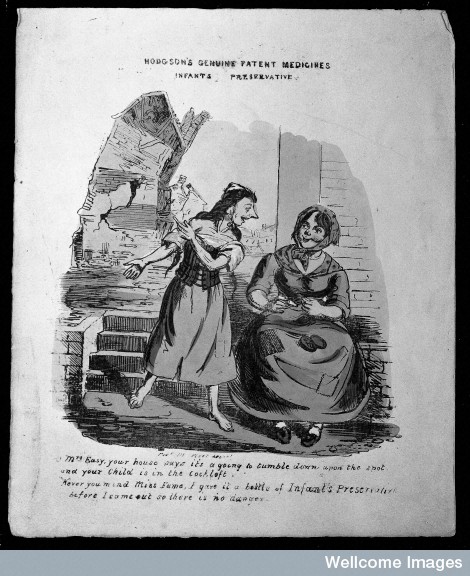 Image credit: Wellcome Images
Image credit: Wellcome Images
Mrs Easy, on the right, is informed that her house is about to fall down with her child inside.
‘Never you mind,’ she says. ‘I gave it a bottle of Infant’s Preservative before I come out so there is no danger.’
.
.
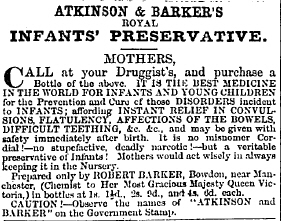
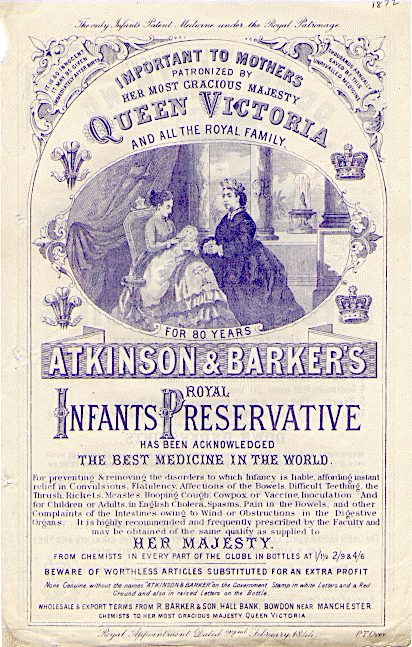
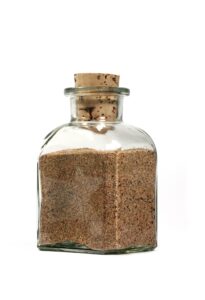
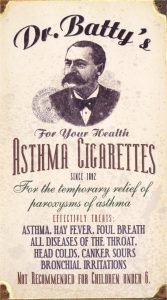
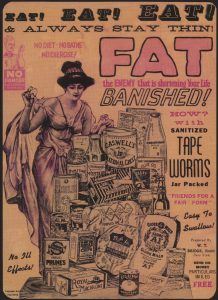
Caroline
Your stories always display exquisite timing in their release of information. The publication of this post is perfectly timed too as there is a striking parallel between elements in this story and the report on homeopathy that the Government published this week.
The report says “The Government Chief Scientific Adviser has discussed the Department of Health policy on homeopathy with lead officials, and understands the reasons for the policy decision. However, he still has concerns about how this policy is communicated to the public. There naturally will be an assumption that if the NHS is offering homeopathic treatments then they will be efficacious …”.
Fortunately homeopathic preparations contain at most homeopathic concentrations of laudanum.
Unfortunately, the Department of Health’s Chief Scientist does not share the concerns of the Government Chief Scientific Adviser.
Thanks Michael. I am fascinated by the parallels between modern and historical remedies and, while I’ve no intention of using the blog to campaign against the quackery of the 21stC, I enjoy being subtly topical where I can. I’m glad others are appreciating this!
This is absolutely fascinating. And with the illustrations, it is also beautiful. And what an insidious thing! I am so glad that I caught your link on twitter!
Thank you, Molly!
Have you got any more information on when this formula seized being used?
Because I know of an “Atkinson’s Preserve” that my own Mother used on us when we were kids in the 1960’s!!! This is shocking!
Appreciate any help here thanks
Hi Roger,
The brand name was still around in the 60s – in fact, I think there’s still an Atkinson and Barker’s Gripe Mixture available today – but fortunately the ingredients had changed!
The opium had been removed by the early 20th century, and the new formula was 7% alcohol and nearly 10% sugar, together with potassium bicarbonate, magnesium carbonate and essential oils of dill, caraway, anise, and almond. I don’t know for certain whether it was still the same in the 1960s but I think it would have been very similar.
Hi Caro,
Thank you for your reply. I was for a while worried somewhat thinking I had been ingesting Laudanum as a child to keep me quiet. The 7% alcohol must have been doing the trick then. LOL. No wonder I still enjoy a few drinks!
Amazing to think that the medical establishment is still for example using ethyl mercury and aluminium in vaccinations and mercury tooth fillings are still with us despite being known neuro toxins! So quackery is still with us.
Hi Caroline, I am completing a PhD in historical archaeology at the University of Queensland. It is a comparative study of orthodox medicines and patent medicine in Queensland 1859-1912 and have included a coroner’s inquiry into the death of an infant in Qld.in 1888, with Atkinson’s Royal Infant Preservative named as a probable cause. I have been searching for a digital image of this bottle for the past three years with no success. Do you know of, or have access to any image of the bottle? In hope…Noel
Hi Noel,
Unfortunately I’ve never encountered an image of the bottle, but if I find one I will let you know.
Caroline
i have dug up a 5″ slim bottle with atkinson and barker down the side. how can i trace the image of the bottle and see if its of any value
@ Paul, I too have a 5″ slim bottle w/ atkinson barker down – did you ever figure out the price?
I would like to use some information from your site in an article How should I credit you? Thanks, love the site!
Anita Britt, Ph. D.
Assistant Professor, Clinical Pediatrics
University of Southern California, Keck School of Medicine
My mom gave all up her eight babies this mixture and we are all fine and I also gave all of my three babies this mixture during their painful teething years.. it was a blessing to me..most people from my island Jamaica gives their babies this product during teething years and no reported death from it. However, the one I am recommending comes in a 4.5 x 1.5 narrow yellow box and the liquid is creamy and yellow as well. There are more than one kind, so be careful!
Where can I buy the one your talking about Elaine need it
I just want to say I gave my son Infant Preservative from the time he was three months old and that was in 1971 I never had a problem with teething or colic and he is now a 6ft 2in tall very healthy happy person, and if I ever have a grand child I will recommend it.
Where can I get it I live in brooklyn dodie
I used it too on our daughter it is fantastic and great for adults. I have no doubt that the reason it it is hard to get is. Because it works and lasts a long time ( so no huge profits for big pharma ) and the Govts don’t wNt healthy kids ,!!
the one I am talking recommending comes in a 4.5 x1.5 narrow yellow box and the liquid is creamy and yellow
I to gave my boys Atkinson & barkers infant carminative in the the 1950’s when they were teething
It worked they never missed a nights sleep. It was a creamy yellow colour
Vonnie
Where can I purchase it from I live in New York
I gave this mixture to my three children in the 70s on my mothers recommendation. They loved immensely without suffering any ill effects.
Suzanne lowery.
Thank you so much, I was feeling very guilty about using this medicine. We lived in Zambia in 1969 and my son had bad colic all the time. The chemist recommended it. My son is now 44 and doing very well. Again long slim bottle yellowy liquid.
We are having work done on our 18th century cottage and digging the footings we have found an intact bottle of Atkinsons, amazing that there is so much information on it.
Ok guys so where can we buy it ? Thanks.